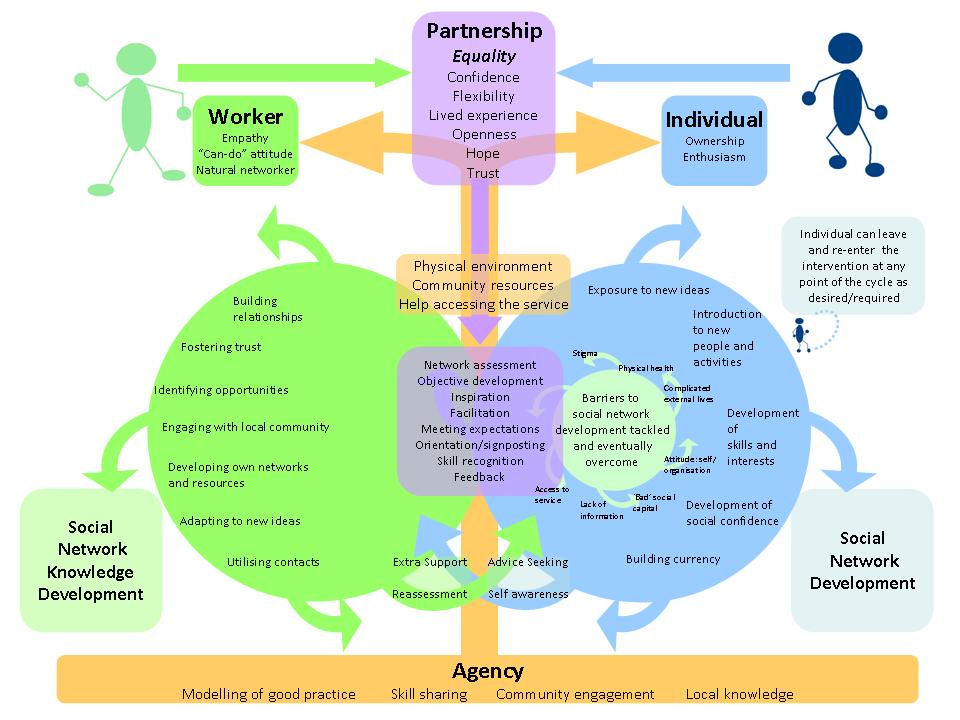The Connecting People Intervention is a way of working that helps users of health and social care services to make new social connections beyond these services. Many of its elements can already be found in routine health and social care practice. But its originality lies in utilising individuals’ strengths to co-produce activities and co-define outcomes. New social connections arise as a bi-product of engaging in this process.
Most health and social care practice takes place in worker-individual partnership dyads. Unless working with groups, workers typically work with one individual or family at a time. This working relationship forms the core of the Connecting People Intervention.
The intervention model does not specify the exact form of the worker-individual partnership dyad, or define a hierarchy of expertise. It is simply two people working together. The dyad could be, for example, two peers supporting one another both simultaneously adopting ‘worker’ and ‘service user’ roles ; the worker could be a qualified or unqualified health or social care worker; or the individual using the service at one point in time could be providing the service at a different point of time.
The Connecting People Intervention operates through the principles and practice of co-production. Rather than a traditional model of workers ‘doing’ and individuals ‘receiving’, workers and individuals co-create the objectives and actions together. Decision making is a shared process and both the worker and individual take responsibility for acting upon the decisions made. Both undertake tasks to keep the intervention ‘wheels’ rotating (see figure below). The Connecting People Intervention is a shared journey of discovery with inputs being invested and outcomes being produced for both the worker and the individual. The New Economics Foundation manifesto for co-production provides an excellent and accessible introduction to the concept of co-production and what it means for public services.

The Connecting People Intervention aims to rotate the green and blue wheels in the model. These represent cycles of discovery for both the worker and individual, which result in the development of new social connections and social networks. But before the wheels can start to spin, the worker and individual both need to be prepared to work together. Ideally, the worker needs to have empathy, a ‘can do’ attitude and be a natural networker, while the individual they are working with needs to have some enthusiasm for engaging in this process and to share ownership of it. Both need to be ready to engage in new situations and meet new people.
The Connecting People Intervention model is not a traditional linear process of a worker doing something for or with the individual and an outcome occurring as a result of this. We use the two interlocking circles to represent the fluidity of the process and the uncertainty about when, or if, new social connections are made. However, there are some important tasks to be undertaken at the beginning of the process.
The worker and the individual start by mapping out the individual’s existing social network. This can be done on a piece of paper by using a series of concentric circles. The individual talks about the people in his or her life who they feel closest to (their names go in the inner circles), followed by those they feel less close to (their names go in the outer circles).
Then, both the worker and individual discuss and write down their own strengths, or assets. These may be their interests; things which they – or other people – think they are good at; or their unique qualities. They will draw on these assets throughout the process of the Connecting People Intervention.
Finally, the worker supports the individual to explore their life goals and to discuss what they would like to achieve. The individual needs to be encouraged to think beyond what the service could provide and to consider new opportunities which they had previously not thought possible. Together, the worker and individual select a goal, or a series of goals, to work towards. The shared development of objectives and activities is at the centre of the model because it represents the co-produced activities. When the worker and individual meet for the first time in the context of this model, they discuss the life goals of the individual and they develop a realistic strategy together to help him or her achieve this. The activities which they undertake to achieve these goals may be in the context of what the agency provides or it may be additional to that.
The process of goal attainment is a shared one, as represented by the overlapping blue and green circles. The worker and individual work in partnership. The individual’s journey (represented by the blue circle on the right) is the focus of the intervention process. In achieving his or her goals, the individual is, for example, exposed to new ideas; introduced to new people and activities; and supported to develop skills, interests and social confidence.
The worker’s journey (represented by the green circle on the left) is equally as important in the intervention process as the individual’s. This assumes that the worker will need to develop their own social network knowledge in order to support the individual on their journey. Workers may need to build relationships; foster trust; identify opportunities; engage with the local community of the individual; develop their own networks and resources; adapt to new ideas; and utilise their contacts in the process of supporting the individual they are working with. At any point, they may need to provide extra support or reassess their involvement, while the individual they are working with may need to seek advice from them and develop their own self-awareness of their journey.
The worker needs to look out for barriers which may prevent the individual’s blue wheel from rotating. These work in the opposite direction to the intervention cycle and can pose considerable challenges for some individuals. Barriers may include, for example, stigma; physical health problems; complicated external lives; countervailing attitudes of self and the organisation providing the context for the intervention; ‘bad’ social capital; lack of information; or poor access to services. These barriers will present the worker with a number of challenges, and helping the individual to overcome them are likely to be the most time-consuming element of their work.
The worker-individual dyad described here takes place in the context of a supportive agency. Without a supportive organisational context, the Connecting People Intervention is unlikely to occur. There are a number of features of a supportive agency context including modelling of good practice; skill sharing; community engagement and good local knowledge. The agency can provide a physical environment which facilitates social connections and can provide useful connections with community resources which individual workers may not have. Shared knowledge of the local community and the intervention model held by the agency can prevent interventions failing when workers leave. This can also help to reduce reliance on individual workers who may be the only ones to hold connections within the local community.
The Connecting People Intervention does not specify what the individual and worker should do within this process as it is up to them to co-produce the activities. However, we anticipate that new social connections may be made at any point in this process. The following case study exemplifies how the Connecting People Intervention works:
Simon and Mina
Simon has a good sense of humour and likes to make other people laugh. His new keyworker Mina helped him to recognise that this was a strength and they agreed to work together using the Connecting People Intervention to help him use his humour to make new social connections.
They began by mapping his social network and found that apart from a few family members and friends he had made from within the service, he did not have many social connections. He felt that the people he knew had heard all of his jokes and he wanted to find new outlets for his humour. Simon wanted to do stand-up comedy, but lacked the confidence to do anything about it and did not think that he would be good enough.
Simon and Mina devised a series of smaller goals for Simon to achieve and identified some potential barriers which may need to be overcome to achieve his ultimate goal. Firstly, they thought that social media may be one way for Simon to test out his humour on other people and help his confidence to grow. Mina and Simon both set up accounts on Twitter and learnt to use it together. Mina supported and encouraged Simon to tweet daily jokes and to follow established comedians to learn how they used comedy in everyday online interactions. Simon’s followers slowly grew in number and gave him confidence in his abilities.
Next, both Simon and Mina arranged an ‘open mic’ night in their agency. This provided anyone with an opportunity to perform music, poetry, comedy or any performing art in front of other people (not just those from within the agency). Simon performed a short routine, which was well received.
Finally, Mina encouraged Simon to participate in a small comedy night at his local community centre. Although very anxious about this, he found the encouragement of his Twitter followers and other people within the agency sufficient to encourage him to put himself in the spotlight. He used a familiar routine and he received a similarly positive response.
In addition to the ‘virtual’ social connections Simon made on Twitter, he met people who attended the local community centre and got chatting to them. They have subsequently kept in contact and occasionally meet up at the local café.
Piloting the Connecting People Intervention
This summer we will be piloting the Connecting People Intervention in health and social care agencies in England. We are still looking for agencies to participate in this study, funded by the NIHR School for Social Care Research.
We wish to select teams for the pilot whose practice is already similar to the model as we appreciate it may take some quite a lot of time and resources to adapt to this way of working. To help us select agencies for inclusion in the study, we are inviting all those who are interested to complete a brief questionnaire about their work. The questionnaire is available here in a word document to download and complete. The deadline for the return of this questionnaire has now been extended to Friday 20th April 2012 (my email address is given at the end of the questionnaire).
I look forward to hearing from you soon!



